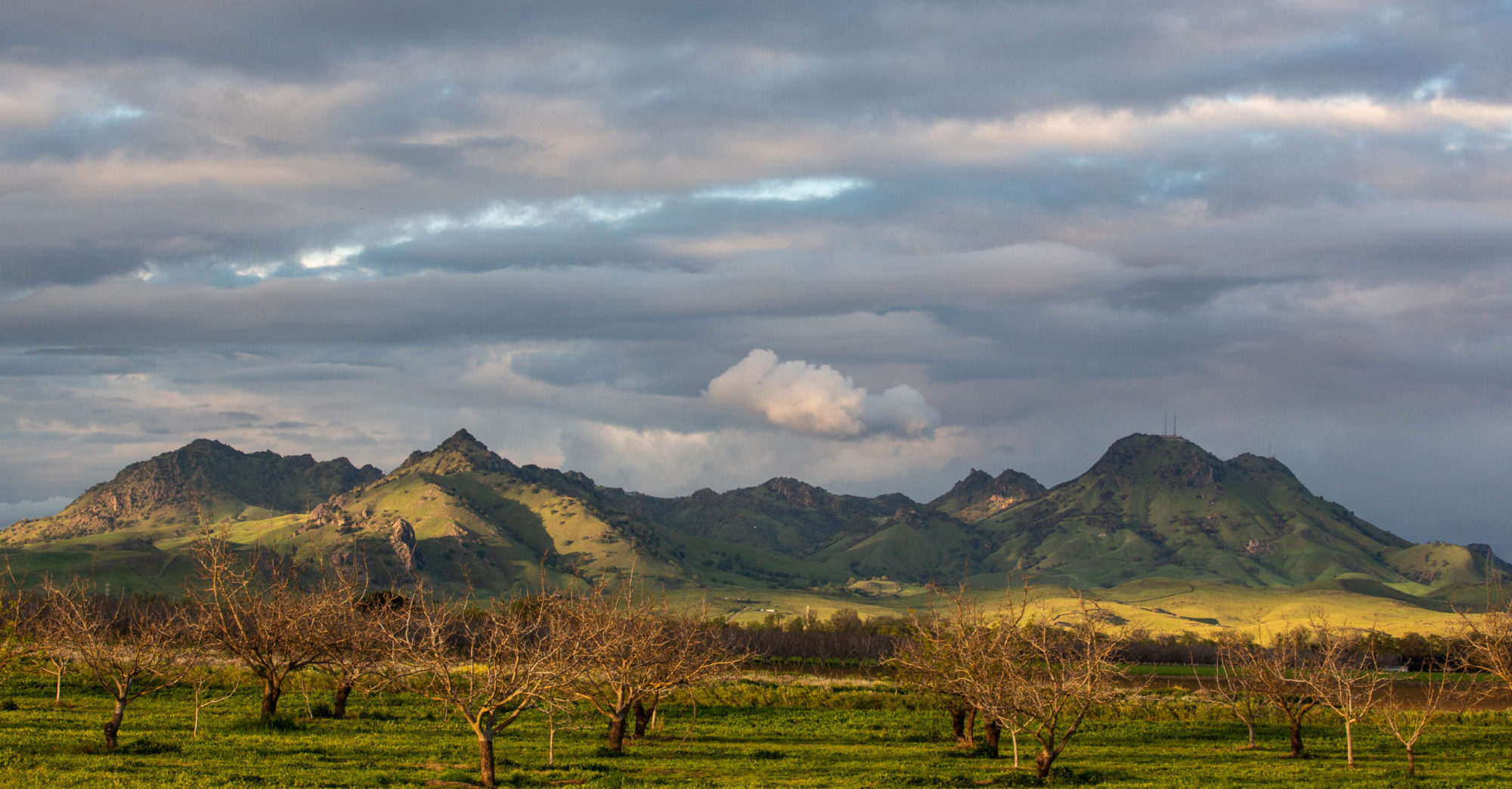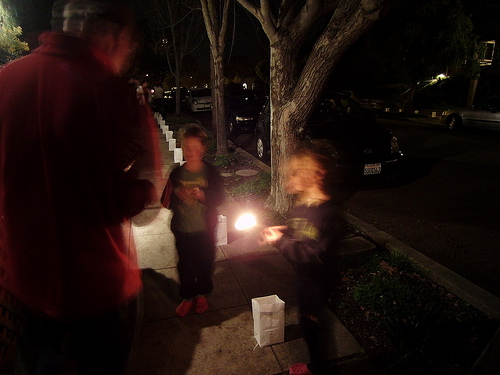The Christmas Eve mulled cider is on (thanks to Kate). Apple juice, citrus, spices, and heat.
Luminaria 2011: Before the Lights
The neighborhood’s getting ready for tonight (“tonight” being this). Dozens of people over at our neighbor Betsey’s house, around the corner, getting luminaria bags and dispatching them via wagon and wheelbarrow all over the neighborhood. It’s still a surprising and amazing spectacle, even after seeing it year after year. (Pictured above: corner of Buena Avenue and California Street).
More later.
Newsroom Xmas Play List
Some of what we were listening to in the San Francisco Public Radio newsroom during our nearly-the holiday shift today (links to come, maybe):
Backdoor Santa/Clarence Carter
Christmas Wrapping/The Waitresses
Fa La Freezing, A Song for Chanukah/Rebecca Bortman
Christmas Card from a Hooker in Minneapolis/Tom Waits
White Christmas/Barbra Streisand
Have Yourself a Merry Little Christmas/Judy Garland
Merry Christmas Everybody/Oasis
Rozhinkes mit Mandlen/Klezmer Conservatory Band
Baby It’s Cold Outside/Glee
Midwinter Graces/Tori Amos
Soulful Christmas/James Brown
Christmas Must Be Tonight/The Band
Miracle/The Maccabeats
The Christmas Waltz/She and Him
Merry Christmas, Baby/B.B. King
Have I Got a Present for You/Toby Keith (A Colbert Christmas)
Christmas in Harlem/Kanye West
And I'll add we didn't play, just because it's one I really love:
The Wexford Carol/Nancy Griffiths and The Chieftains
Some North Berkeley Flatlands Luminaria History
It’s almost that time again: Christmas Eve, the night of nights in our humble 99 percent neighborhood, where we express solidarity with all who celebrate light at this dark end of the year with–what? Paper bags, sand, and candles, also known as luminaria, luminaries, farolitos, and many other names that I am sure exist but have not yet come to my notice. Our one-night fete is the 24th, and this year will be the 20th time the neighbors here have gotten together to do this. Here are some posts from years past:
2010
Berkeley Luminaria: 2010 Edition
2009
‘Always on Christmas Night …’
2008
Luminaria Rainout
Happy Last of the Year
2007
Luminaria 2007
2006
Luminaria Streets
Hot Xmas Eve Bag Action
2005
Luminaria ’05: Pregame Report
Luminaria ’05: First-Half Action
Luminaria ’05: Second Half, Game Summary
Luminaria ’05: Maps
Morning-After Disassembly Line
2003
Luminaria
Weathermen of Yesteryear
I grew up in Chicago, meaning I grew up on Chicago TV. In our house, the local news was a staple, and I’m inclined to believe it wasn’t bad though maybe it was also not as good as I sometimes tell myself it was. Anchor and reporter names I recall include Floyd Kalber, Frank Reynolds, Fahey Flynn, Bill Kurtis, Jane Pauley, Barbara Simpson, and Walter Jacobsen. Some of them went on to work with the national networks, for what that’s worth.
And then there were the weathermen. (Yes, they were all guys.) I think of them not because they were great, although I again lean toward the view they weren’t bad. I suppose there’s a book or at least a long essay on how we have come to see and think of the weather in the electronic meda age compared to earlier eras going back to the time when we guessed at the day’s conditions by looking to the horizon and sniffing the wind.
For better and worse, here are the weathermen who delivered the forecasts to my impressionable young mind:
P.J. Hoff, who cartooned the weather on the CBS affiliate, WBBM, Channel 2. He had a character named Mr. Yellencuss that I imagine he’d draw when bad weather was in the offing.
Harry Volkman, who worked on several Chicago channels and seemed to pride himself on (and was given credit for) the “professionalism” of his forecasting (he’s the first TV weather guy I recall displaying a seal from the American Meteorological Society during his broadcasts).
John Coleman, part of the first “happy-talk” Chicago news team on Channel 7, WBKB (later, WLS). In my book, his claim to fame, which was a pretty good one, was to forecast Chicago’s January 1967 blizzard (while he was doing weather on Milwaukee TV). According to his own account (in the comments to a post about Chicago’s Groundhog’s Eve Blizzard of 2011), Channel 7 hired him immediately after the storm, and I kind of remember him on Channel 7 by the time another storm hit two weeks or so after the first one). He went on to national TV and was a cofounder of The Weather Channel. And today, bless him, he’s a loud voice in contesting the case for climate change.
There were others, but they’ve faded from memory if in fact they ever made much of an impression. I ought to mention Tom Skilling as a great Chicago weather guy–the greatest, for my money–but he is very much of the present era.
Dry December Update
“Rain, rain, rain, rain,
Why’d you cause me so much pain?”
—”The Rains Came,” Sir Douglas Quintet
Southern California got a little spritz of rain over the weekend—nearly a fifth of an inch yesterday in the desert town of Blythe. Here, it’s dry, and the California-Nevada River Forecast Center sees only a small chance that rain will fall over the northern part of the state in the next week (and that will be far north of the Bay Area). Our local National Weather Service forecast office, in Monterey, reads the models the same way: “Dry and mild weather will continue through at least the next 7 days … with little variation in the upper level weather pattern. A series of storm systems will move towards the region over the next week … but pass to the north and east of the area. ” The longer-range outlook from NOAA’s Climate Prediction Center is for drier and warmer than median weather.
Here’s the local NWS table on precipitation so far this year. And below that, today’s theme song
| Station | July 1-Dec. 18, 2011 | % of Normal | July 1-Dec. 18, 2010 | % of Normal | July 1-Dec. 18 Normal | July 1-June 30 Normal |
| SFO Int’l Airport | 2.87 | 50 | 5.76 | 101 | 5.69 | 20.11 |
| Oakland Airport | 3.06 | 52 | 6.66 | 113 | 5.91 | 17.42 |
| Mountain View Airport | 1.73 | 45 | 3.24 | 85 | 3.83 | 13.35 |
| San Jose Airport | 1.53 | 39 | 3.05 | 77 | 3.95 | 15.08 |
| Santa Rosa Airport | 4.45 | 42 | 13.19 | 123 | 10.70 | 31.91 |
| Salinas Airport | 3.31 | 103 | 3.45 | 107 | 3.21 | 12.91 |
| San Francisco Downtown | 3.35 | 47 | 7.88 | 111 | 7.08 | 22.28 |
Chicken Coop Portraiture
Among my many other claims to greatness, I’m currently the Mayor of Berkeley’s Edible Schoolyard Chicken Coop on Foursquare (I know–it’s hard to believe I’ve been able to fit so much into one short life). The coop is a regular stop on our Saturday morning perambulation through the neighborhood with The Dog; his attention focuses alternately on the chickens, who I imagine look like tasty friends, and the many squirrels chasing through an adjacent live oak. The chickens are fascinating to me, too–mostly in that this group (about 15 chickens and two or three ducks) has, notwithstanding the occasional expiration, appeared to stay so healthy for so long.
Journal of Self-Promotion, Sports Radio Edition
A week of light posting because, well, there was work to do. I got to do a little radio feature on the San Francisco 49ers for an NPR sports show produced at Boston’s WBUR, “Only A Game.” It was sort of a quick-hit story, and the field reporting involved going to a couple fan bars last Sunday. People were amazingly willing to talk, for the most part, and they were not even liquored up. The folks at WBUR did a very nice job on the story, too.
Link to the story page: Jim Harbaugh Inspires ‘Niners to Division Title
And the MP3 link to the story audio.
Oh, yeah, and here’s the rap that’s referenced in the story:
Hey, Rainmaker
A dry summer, and then comes the fall
Which I depend on most of all.
Hey rainmaker can you hear the call?
Please let these crops grow tall.—The Band, “King Harvest”
We had some rain overnight–just enough to keep the dust down, if there had been any dust (we did have plenty of crap in the air, though: a miasma of car exhaust, smoke, and other metropolitan exhalations that led the regional air district to ban wood fires for four days in a row). The “storm” total in San Francisco for the rain that started falling last night is .04 of an inch–four-hundredths–and according to the National Weather Service is the first rain since we got .21 of an inch on Thanksgiving.
Meantime, continuing my claim to be the first in my neighborhood to express precipitation anxiety this year, the state Department of Water Resources and its California Data Exchange Center are out with their latest summary of hydrologic conditions for the state. Here’s my summary of their summary: November 2010 was wet, November 2011 was dry. Or in the summary’s own machete-proof prose:
On November 30, the Northern Sierra 8-Station Precipitation Index Water Year total was 6.5 inches, which is about 70 percent of the seasonal average to date and 13 percent of an average water year (50.0 inches). During November, the total precipitation for the 8-Stations was 2.6 inches, which is about 41 percent of the monthly average. Last year on November 30, the seasonal total for the 8-Stations was 15.5 inches, or about 167 percent of average for the date. On November 30, the San Joaquin 5-Station Precipitation Index Water Year total was 4.0 inches, which is about 59 percent of the seasonal average to date and 10 percent of an average water year (40.8 inches). During November, the total precipitation for the 5-Stations was 1.5 inches, or about 32 percent of the monthly average. Last year on November 30, the seasonal total for the 5-Stations to date was 14.4 inches, or about 212 percent of average for the date.
Of course, one or two good drenchings will make all this early-season anxiousness go away.
Related:
It’s December. Do You Know Where Your Rain Is?
KQED: California Reservoir Watch


